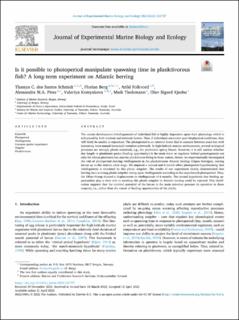| dc.contributor.author | dos Santos Schmidt, Thassya Christina | |
| dc.contributor.author | Berg, Florian | |
| dc.contributor.author | Folkvord, Arild | |
| dc.contributor.author | Pires, Alessandra M.A. | |
| dc.contributor.author | Komyakova, Valeriya | |
| dc.contributor.author | Tiedemann, Maik | |
| dc.contributor.author | Kjesbu, Olav Sigurd | |
| dc.date.accessioned | 2022-09-09T11:33:13Z | |
| dc.date.available | 2022-09-09T11:33:13Z | |
| dc.date.created | 2022-05-09T10:32:23Z | |
| dc.date.issued | 2022 | |
| dc.identifier.issn | 0022-0981 | |
| dc.identifier.uri | https://hdl.handle.net/11250/3016888 | |
| dc.description.abstract | The oocyte development (vitellogenesis) of individual fish is highly dependent upon their physiology which is influenced by both intrinsic and extrinsic factors. Thus, if individuals encounter poor biophysical conditions, they will likely be unable to reproduce. The photoperiod is an external factor that is constant between years but with increasing intra-annual (seasonal) variation polewards. In high-latitude marine environments, several ecological processes are strongly photic entrained, e.g., the planktonic spring bloom. However, it is still unclear whether day length or planktonic peaks (feeding opportunity) is the main timer or regulator behind gametogenesis not only for teleost piscivores but also for planktivores living in these waters. Hence, we experimentally investigated the role of photoperiod steering vitellogenesis in the planktivorous Atlantic herring (Clupea harengus), rearing larvae up to the mature adult stage. We imposed a natural and 6-month offset photoperiod hypothesising that vitellogenesis is entrained by this photic zeitgeber. The results of our experiment clearly demonstrated that herring have a strong photic zeitgeber acting upon vitellogenesis according to the experienced photoperiod. Thus, the Offset Group showed a displacement in vitellogenesis of 6 months. The second hypothesis that feeding opportunities play a clear role in assisting this photic zeitgeber in Atlantic herring could be rejected. This clarification supports that the survival potential of the larvae is the main selection pressure in operation in these respects, i.e., rather than the extent of feeding opportunities of the adults. | en_US |
| dc.language.iso | eng | en_US |
| dc.publisher | Elsevier | en_US |
| dc.rights | Navngivelse 4.0 Internasjonal | * |
| dc.rights.uri | http://creativecommons.org/licenses/by/4.0/deed.no | * |
| dc.title | Is it possible to photoperiod manipulate spawning time in planktivorous fish ? A long-term experiment on Atlantic herring | en_US |
| dc.type | Journal article | en_US |
| dc.type | Peer reviewed | en_US |
| dc.description.version | publishedVersion | en_US |
| dc.rights.holder | Copyright 2022 the authors | en_US |
| dc.source.articlenumber | 151737 | en_US |
| cristin.ispublished | true | |
| cristin.fulltext | original | |
| cristin.qualitycode | 1 | |
| dc.identifier.doi | 10.1016/j.jembe.2022.151737 | |
| dc.identifier.cristin | 2022580 | |
| dc.source.journal | Journal of Experimental Marine Biology and Ecology | en_US |
| dc.relation.project | Havforskningsinstituttet: 15205 | en_US |
| dc.relation.project | Havforskningsinstituttet: 14861 | en_US |
| dc.relation.project | Norges forskningsråd: 254774 | en_US |
| dc.identifier.citation | Journal of Experimental Marine Biology and Ecology. 2022, 552, 151737. | en_US |
| dc.source.volume | 552 | en_US |

